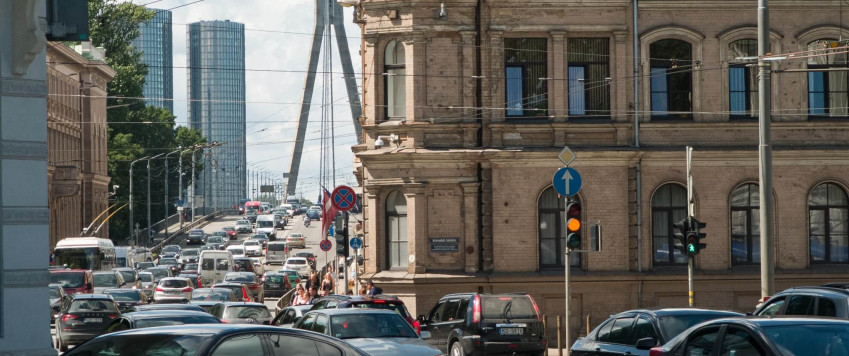What will higher interest rates entail for Latvia's economy?

Inflation in Latvia has reached a historically high levels, exceeding 20% for several months now. The fact that inflation in Estonia has reached even higher levels or that a rise in inflation not witnessed for decades affects almost every developed country in the world offers little solace to the households who face hefty electricity and heating bills and growing food prices. In many European countries, the unpleasant circumstances have made governments seek solutions that could help the population to cope with the increasing costs of living. These include setting energy price caps, direct handouts to households and many others. Also European Central Bank has contributed to the fight against inflation: it has substantially increased interest rates. You read it correctly: the European Central Bank have raised interest rates to reduce inflation. How exactly will higher interest rates help to slow inflation down?
Īsumā
-
the unprecedented increase in inflation in many parts of Europe make governments search for solutions that could shield households from the rising costs of living;
-
to ensure that inflation does not become entrenched, the European Central Bank (ECB) is raising interest rates;
-
higher interest rates will pose a series of challenges for the businesses and households with a heavier debt burden;
-
nevertheless, the impact on Latvia's economy is overall limited by the relatively low debt burden.
When inflation is triggered by overheated economy, i.e. in a situation where demand for goods and services exceeds the ability of businesses to meet it, higher interest rates and their consequences, higher monthly loan payments and fewer new loans, allow for cooling the economy and slowing down inflation.
At the moment, there is little reason to talk about overheating of the economy, and inflation is mostly determined by other factors related to global developments. A major role is played by Russia's invasion of Ukraine that forced Europe to swiftly review its energy policy. The consequences of this invasion are reflected in unprecedented price hikes of natural gas and other energy sources. We also continue to face supply chain bottlenecks that push up transportation costs of goods and eventually their final price as well. It is clear that higher interest rates will not directly solve any of these problems and it would be naive to expect a rapid decrease in inflation over the coming months.
However, higher interest rates serve another very important purpose – to make sure that inflation does not become entrenched. A rise in interest rates proves that the ECB will take all necessary steps, including deliberately slowing down economic activity, to bring inflation back to its 2% target as soon as possible. In the absence of a decisive action by the ECB, a considerable risk of changes in public perception of inflation would persist. It is one thing to live with elevated inflation for a certain period of time, while realising that the situation will soon improve. It is a completely different story if society expects that the inflation is here to stay. Under this scenario, the inflation would become much more persistent: employees, in anticipation of further inflation, would justifiably ask for wage increases, while businesses would, so to speak, "finance" higher wages through raising prices. This would lead to the emergence of a wage-price spiral. History shows that the only way out of such a situation is a deep and severe crisis. Higher interest rates serve as a bitter pill that helps to eliminate, on a timely basis, the risk of finding oneself in a spiral of rising prices and wages. The pill is bitter because higher interest rates also entail economic slowdown.
How bitter will the pill of higher interest rates be for Latvia's economy?
First, households in Latvia will have to cope with higher monthly mortgage payments that alongside the increased spending on heating will make them review other expenses. In Latvia, adjustable rate mortgages (which make up for vast majority of mortgages) are mostly connected with the short-term EURIBOR that reached 1% in mid-September. Financial markets expect interest rates to rise further, reaching their highest level in summer 2023 when the short-term EURIBOR is expected to be close to 3%. It would still be below the level once considered a norm: over the period from the introduction of the euro to the financial crisis in 2009, the average EURIBOR stood at approximately 3.5%; however, it would still constitute a significant increase after almost a decade of negative interest rates.
Chart 1. Three-month EURIBOR (historical data and outlook derived from futures; %)
Source: Bloomberg (data obtained on 19 September 2022).
What does the increase in interest rates entail for the borrower?
Each particular case will, of course, depend on a series of factors – the outstanding amount of the loan, maturity, the type of payment, etc. – but for most households such an increase in interest rates will raise their monthly payments by approximately 60 euro. Other borrowers will find themselves facing a more substantial increase in monthly payments: about a quarter of borrowers will see their interest expenditure go up by more than 100 euro, and about 5% – by more than 200 euro.
Such expenditure growth can undoubtedly cause headache; however, looking at the economy as a whole, it seems that the increase in the loan payment burden is rather limited: additional spending on interest payments constitute approximately 0.2% of GDP. The reason for this is the relatively sluggish lending activity observed in Latvia since the global financial crisis. Namely, household debt in Latvia is very low; therefore, the impact of the rise in interest rates is also rather limited. The household resilience to higher rates is also confirmed by the fact that despite hikes in monthly loan payments they still account for a relatively small part of income [1].
Is the picture similar in the corporate sector?
As a result of the very sluggish lending activity over the recent years, the negative impact from growing interest expenses will be quite limited in the corporate sector as well. Nevertheless, businesses will be affected (and potentially – much more dramatically) by a falling demand in export markets. While the corporate and household debt in Latvia constitute approximately 30% of GDP, this figure reaches an average of almost 90% in the euro area. This means that hikes in interest rates will also affect the economy of these countries much more severely. Ultimately, the decline in economic activity in our principal trading partners will also affect the demand for goods produced and services provided by our own businesses. Accurate estimation of the impact on Latvia's economy is unclear. Nevertheless, historical evidence suggest that the estimated impact of the contraction of external demand by 1% on Latvia's GDP would be about 0.4%.
Will the government costs grow as well?
Higher interest rates also result in higher borrowing costs for the government. Government support for the economy during the pandemic (as well as during the current crisis) has caused a surge in the total government debt to 14 billion euro (or 45% of GDP). Intuitively, it might seem that a larger government debt would also entail high interest payments; however, currently they stand close to the lowest level since the restoration of independence – about 0.5% of GDP. This is due to the successful work carried out over the previous decade when government debt was refinanced at record-low interest rates. For example, in 2021, the Treasury issued bonds in the amount of 1.4 billion euro at a coupon rate of 0%: in other words, without paying any interest. Unlike households and businesses, the government interest payments do not change together with market rates; therefore, there will be no surge in debt service payments, at least not in the near future[2].
Conclusion
All these factors give reason to believe that the expected impact of higher interest rates on Latvia's economy might be overall rather limited. I say "overall" on purpose, as some businesses and households with a greater debt burden might encounter rather serious challenges. While the impact of higher interest rates is in itself low, it brings about quite unpleasant effects in combination with heavy heating bills and rising food prices. It will not be a surprise if the economy plunges into recession. Yet, the alternative is even less attractive: history suggests that a cure for an entrenched inflation is solely a deep and severe crisis. It would affect a much larger section of society.
[1] Despite growing interest rates, debt service to income ratio for almost 90% of borrowers should not exceed 30% of their income. It is also worth noting that households with mortgage loans are relatively well-off. Approximately a third of the 20% of the wealthiest households have mortgage loans, while this figure falls below 5% with regard to the 20% of the poorest ones.
[2] This does not apply to new borrowing which is subject to the current market rates
Vēlos informēt, ka tekstā:
«… …»
Jūsu interneta pārlūkā saglabāsies tā pati lapa






